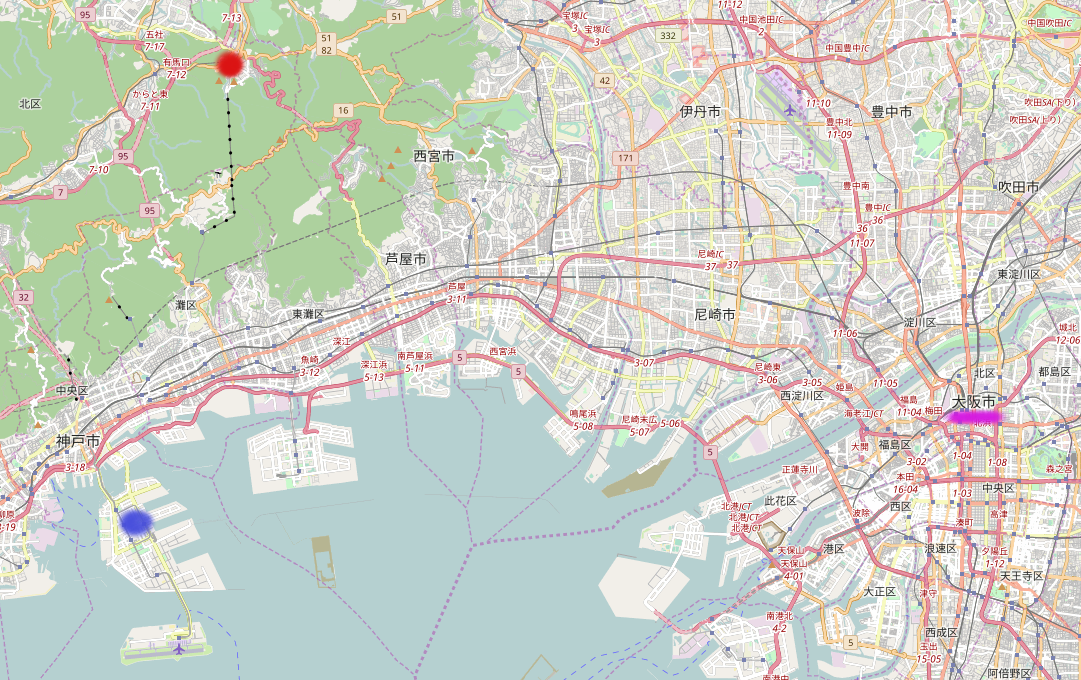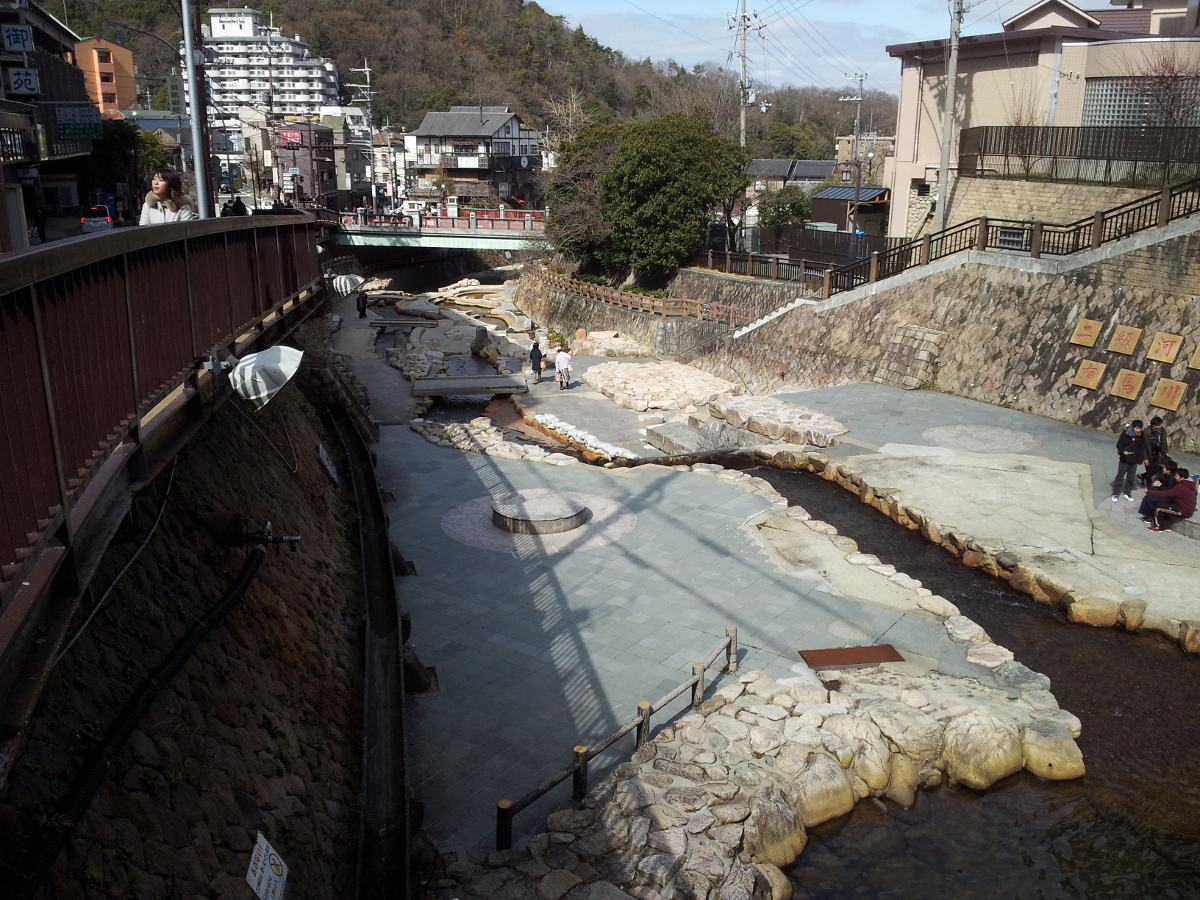Arima Onsen
※ This article discusses our Arima Onsen visit on 27th of February 2017.
I planned to meet with my Karate friend since christmas time. He left university after 3 years and stopped attending Karate lessons (like me). Yesterday he texted me and we brainstormed ideas. He neither has been to Himeji Castle nor Arima Onsen. Going to an onsen with a Japanese is a very good opportunity. Depending on the onsen, language translation in English might not be available and the onsen customs are different to other cultures. The first one does not hold for the very famous Arima Onsen for 90% of the texts. Once, you have been in some onsen, feel free to go to any other. You will be familiar with the customs. Many videos on onsen customs exist (like the one by Notes of Nomads).
All videos on onsen start with "You will be naked. Don’t go there, if you feel uncomfortable in front of other people naked". I agree. Though I cannot relate to this being raised often bathing naked publicly in Austria.
Requisites: Most onsen don’t provide towels for you. So take one for your hair and one for the body with you. A bottle of water is also recommended, if you don’t like Japan’s tap water, like me. To carry your wet towels home, take an appropriate bag with you. I took a bag made of fabrics with me.
We met at 11:00 in Kobe to go to Arima by train together. I lost track of time and my surrounding because we chatted all the time. First, we talked a lot about his current life situation. Because of his debt due to tuition fee credit (compare with Kobe university tuition data), he has to find a job until April 2018. He is currently targetting one specific company and he just returned from the company visit for 3 days (I am not sure why he called it internship; to me it’s something different). While chatting, we switched trains 2 times to reach Arima Onsen. We reached Kita-ku (the corresponding district) approximately at noon (costs: 930 Yen).

In this map, Arima Onsen is colored red (top-left), my place of living is colored blue (bottom-left, part of Kobe) and Osaka is colored purple (middle-right).
In Kita-ku, I showed him the link:/gallery/2017.01.02 - Arima Onsen Irizomeshiki/#/17[foot bath] and next to the foot bath, kinsen ( 金泉 , きんせん, gold spring) is located. Also called "kin no yu" ( 金 の 湯 , きんのゆ). At Arima Onsen, you can choose between a bath in "golden" water (more like brown, like in the foot bath photo) or "silver" water (more like transparent). We went to the golden spring first.
-
Take off your shoes as usual. Put your shoes into a shoe locker. Depending on the onsen, you might need a 100 Yen coin. At kinsen you don’t need a coin.
-
Buy a ticket at the machine (costs at kinsen: 650 Yen).
-
Go into the dressing room. Blue indicates the room for men, red indicates the room for women. From now on, men and women are separated.
-
Put your belongings into the locker. Get naked. In general, you don’t need to take a towel with you. If you take it with you into the bath, you have to balance it on top of your head all the time.
-
Read the many, funny warnings in front of the bath door. For example, you are not allowed to poop or pee in the bath.
-
Enter the bath. It will be very steamy.
-
Go to the shower area. You need to sit down (reason: you don’t splash so much sitting). Wash your whole body. Shampoo and body lotion are provided. Often Japanese fill the bowl with water and pour it over their body. A separate area features two standing showers as I am used to in Austria.
-
At kinsen, you can choose between 3 areas. To the right of the entrance, the bath has a temperature of 44°C. The bath in the back has a temperature of 40°C, if I remember correctly. And the bath to the left is the coldest with about 37°C. Children have spent their time there.
-
Be sure not to overdo it. High temperatures are exhausting for your blood circulation.
-
Leave the bathing area as you like. Try to dry yourself as good as possible.
-
Dry yourself with the towels from the locker. Hairdryers are provided.
-
Dress yourself. Leave the dressing room.
-
My Japanese friend told me Japanese usually drink milk afterwards. You can buy raw milk, coffee-flavored milk and fruit-flavored milk at the vending machine (costs: 150 Yen).
-
Take your shoes from the shoe locker and leave.
In the dressing room, I read some Kanji and my friend confirmed my readings. An elderly man pointed me to the English translation, which I saw of course before. I need to point out, that a Japanese people typically looks for Kanji right away, because in their mindset it is the "simple" script. However, as an Austrian, I immediately look for Latin characters as they are "easy" to me. So the characters, attracing our attention, are different ones. Anyhow, the elderly man used the Kanji reading to start a discussion. He asked me for my origin. After correcting Australia to Austria, he introduced himself as someone who visited Innsbruck and he switched to German. He got few inflections of verbs wrong, but his German was very good. He gave me his business card and he is actually a Professor Emeritus from a university in Osaka. What a funny experience.
We left and went to get a cake right in front of kinsen. カフェドボウ (Café De Beau) offered a small Arima cake for 250 Yen. Actually my friend wanted to get some ramen first, but he mixed up the restaurants. The second restaurant was 青龍居 . I don’t know how to pronounce the restaurant’s name, but probably something like aotatsui (あおたつい). We ate some ramen (costs: 750 Yen) and my friend ate the meat of my ramen (being a vegetarian in Japan). Our chats ranged from places, where we have been, to our thoughts on Kobe university and our future.
We went for a walk in Kita-ku and not unintentionally, we soon reached ginsen ( 銀泉 , ぎんせん, silver spring). This is also called "gin no yu" ( 銀 の 湯 , ぎんのゆ). The same procedure like above has to be performed with costs of 550 Yen entrance fee and 150 Yen for another milk, I bought. There is only one area and the water has a temperature of about 38°C. This was very comfortable. I prefer fruit-flavored milk over coffee-flavored milk. My friend looked up the next bus to go home. At the station, they told us that the last bus left already (at about 16:30). So we took the train instead (costs: 930 Yen again). I told him about Austrian hot springs, what sports we like and showed him some photos of my past. I waved him goodbye at Kobe-Sannomiya.
So, what was the experience like?
-
The temperature is higher than in Austria. Austrian hot spring typically feature 35°C to 38°C as far as I remember. This is also because of a missing outside zone. The entire bath is in one big room (separating men and women by a huge wall). So the heat stays inside and maybe also the water is naturally just hotter than in Austria.
-
One room also means the onsen is actually tiny compared to Austrian hot springs. In Austria, I am thinking of Bad Blumau which features areas which are very huge and many people can be in the bath at the same time. In kinsen, the hot 44°C bath can take up to 8 people. Then it gets crowded.
-
The most extraordinary experience, in my opinion, was taking the shower seated. But it is nothing difficult.
-
I like the fact that my body got very warm compared to my ever cold room in the residence.
-
Unlike in Austria, chatting in an onsen bath is generally uncommon. I am not a fan of this. But we chatted with a low voice anyways.
-
Arima Onsen has many nice snacks available. I knew them from my previous visits and my friend was not interested. So did not consume anything from the booths near the street.
I liked it. Unlike my Japanese friend, I think 550 Yen is not too much, if you can stay inside (technically) the whole day. But public transport of 1860 Yen in both directions from Kobe is expensive. If you consider it as a short trip after work, bathing in a Japanese onsen is a pleasant experience. If you want to spend a night at an onsen (or ryokan) and relax for a few days, I definitely prefer the Austrian style.
Thanks for being there with me, friend!
